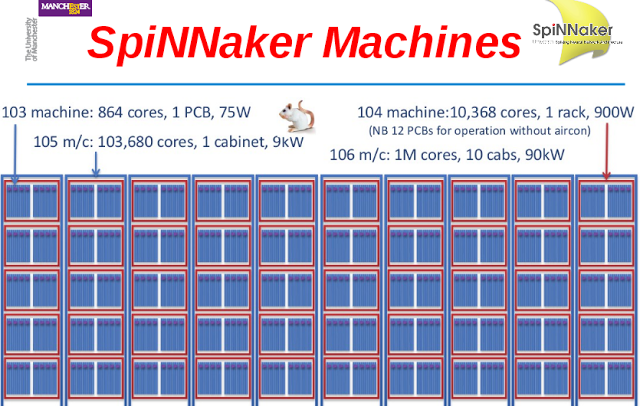SpiNNaker (a contraction of Spiking Neural Network Architecture) is a million-core computing engine whose flagship goal is to be able to simulate the behaviour of aggregates of up to a billion neurons in real time (1% of the human brain). It consists of an array of ARM9 cores, communicating via packets carried by a custom interconnect fabric. The packets are small (40 or 72 bits), and their transmission is brokered entirely by hardware, giving the overall engine an extremely high bisection bandwidth of over 5 billion packets/s. Three of the principle axioms of parallel machine design – memory coherence, synchronicity and determinism – have been discarded in the design without, surprisingly, compromising the ability to perform meaningful computations. A further attribute of the system is the acknowledgment, from the initial design stages, that the sheer size of the implementation will make component failures an inevitable aspect of day-to-day operation, and fault detection and recovery mechanisms have been built into the system at many levels of abstraction. This paper describes the architecture of the machine and outlines the underlying design philosophy; software and applications are to be described in detail elsewhere, and only introduced in passing here as necessary to illuminate the description.
Here is a 41 page presentation on Spinnaker
1 million cores are in 50,000 chips which are in 10 server cabinets.
SpiNNaker machines are classified by the the (approximate) number of processor cores, thus the 10N machine has approximately 10^N processor cores. The 102 and 103 machines are single printed circuit boards, already available or in the final stages of design. The larger machines are racks or cabinets and specifications are subject to change.
If you liked this article, please give it a quick review on ycombinator or StumbleUpon. Thanks

Brian Wang is a Futurist Thought Leader and a popular Science blogger with 1 million readers per month. His blog Nextbigfuture.com is ranked #1 Science News Blog. It covers many disruptive technology and trends including Space, Robotics, Artificial Intelligence, Medicine, Anti-aging Biotechnology, and Nanotechnology.
Known for identifying cutting edge technologies, he is currently a Co-Founder of a startup and fundraiser for high potential early-stage companies. He is the Head of Research for Allocations for deep technology investments and an Angel Investor at Space Angels.
A frequent speaker at corporations, he has been a TEDx speaker, a Singularity University speaker and guest at numerous interviews for radio and podcasts. He is open to public speaking and advising engagements.



